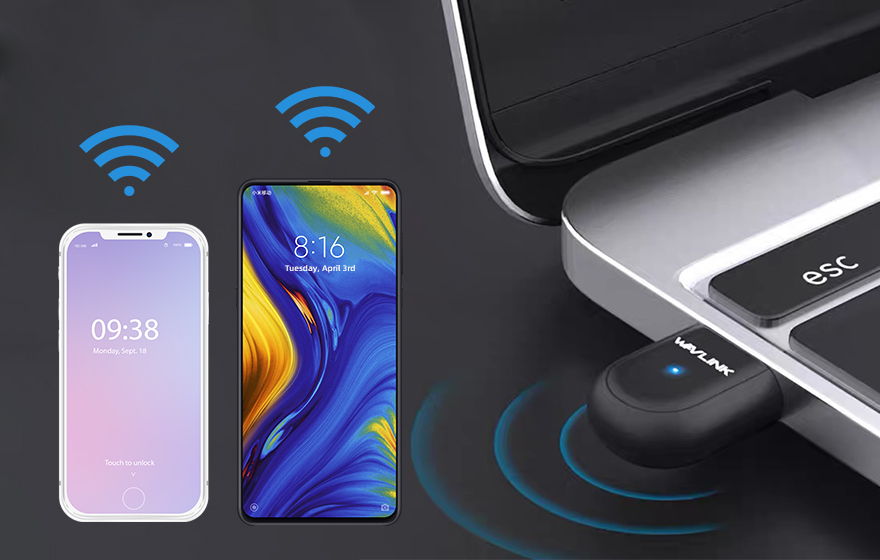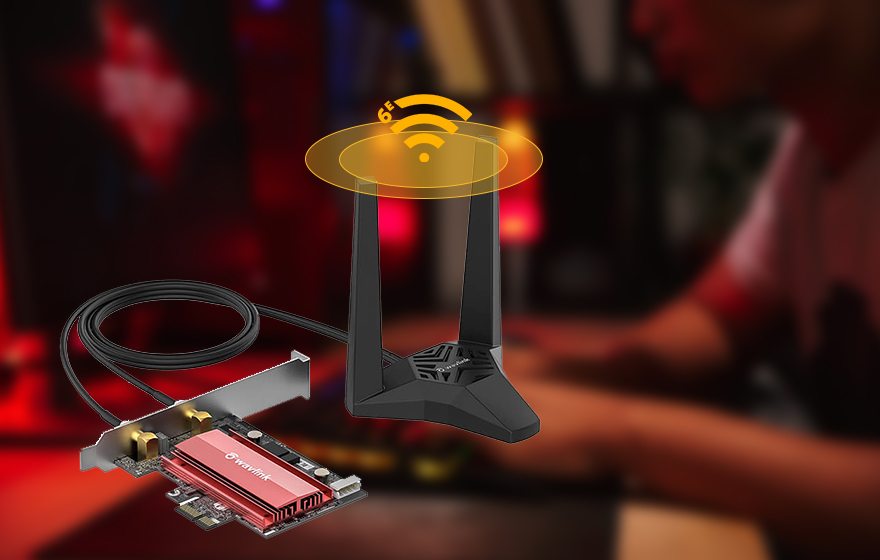We've all faced the frustration of poor Wi-Fi signals on our PCs or laptops. Sometimes, the slow speeds aren't the router's fault but rather our device's weak Wi-Fi receiver. Thankfully, The solution is straightforward: a high-performance wireless adapter.
This article aims to simplify Wi-Fi adapters, , shedding light on their purpose, functionality, various interface types, and how to select the right one to meet your needs.
What Is a Wi-Fi Adapter?
A Wi-Fi adapter, also known as a wireless network adapter, is a device that enables your desktop computer or laptop to connect to wireless networks. Essentially, it acts as a bridge between your device and your home's wireless router, allowing you to access the internet wirelessly.
While most modern laptops come equipped with built-in Wi-Fi capabilities, you may still require a Wi-Fi adapter to upgrade or enhance your wireless connectivity. These adapters ensure compatibility with the latest Wi-Fi standards and deliver improved signal reception and overall performance.
Types of Wi-Fi Adapters
Wireless adapters come in various interfaces to accommodate different types of devices. These include:
1. USB Wi-Fi Adapters
2. PCIe Wi-Fi Adapters
3. M.2 WiFi Cards
1. USB Wi-Fi adapters

USB Wi-Fi adapters are among the most common and user-friendly plug-and-play external Wi-Fi devices. Whether you have a desktop or laptop, you can simply plug them into a USB port, and they're ready for action.
If you prefer a hassle-free solution without the need to open your computer case, USB Wi-Fi adapters are your best bet. They come in two main varieties: those with external antennas and those without.
USB Wi-Fi Adapters with External Antennas: These adapters excel in signal reception, extending your connectivity range and coverage. Some models even feature multiple external antennas with cable connections, allowing for flexible antenna placement.
For instance, Wavlink AC1900 WiFi 5 Dual Band USB3.0 Adapter, equipped with four 5dBi high-gain antennas, significantly enhances reception and sensitivity, providing stable internet access over long distances.
USB Wi-Fi Adapters without External Antennas: On the other hand, USB Wi-Fi adapters without external antennas are compact and portable, making them ideal for laptops. They blend discreetly when plugged into a notebook's USB port. In appearance, these compact USB Wi-Fi adapters are reminiscent of Wi-Fi dongles used for connecting peripherals like keyboards and mice.
Selecting an adapter with or without antennas comes down to your network coverage and style preferences. If your network is strong or you value portability, go for a sleek USB Wi-Fi adapter. But if you're all about maximizing your network performance, opt for one with external antennas. It's the key to boosting your Wi-Fi experience.
2. PCIe Wi-Fi Adapters

PCIe wireless adapters are designed for desktop computers, slotting into the PCIe interface on your computer's motherboard, much like installing a GPU (Graphics Card). While their installation is more complex than USB adapters, PCIe adapters offer stable and faster transmission speeds.
Furthermore, PCIe Wi-Fi adapters often incorporate Bluetooth functionality, providing a dual-purpose upgrade for your computer.
For instance, Wavlink AX3000 Next-Gen WiFi 6 Dual Band PCIe Adapter with Bluetooth 5.2 supports the latest Wi-Fi 6 (802.11ax) standard, offering speeds of up to 3000Mbps. It also employs advanced technologies such as OFDMA and MU-MIMO, ensuring optimal performance in crowded networks.
Wavlink AX3000 PCIe adapters come with two 5dBi antennas to extend your Wi-Fi reception, and the magnetic antenna base allows for flexible positioning to achieve the best signal reception.
3. M.2 WiFi Cards
M.2 WiFi cards are compact wireless networking cards commonly used in laptops, tablets, and other wireless-capable devices.
By inserting an M.2 WiFi card into your laptop's M.2 slot, you can upgrade an older laptop to the latest Wi-Fi standards, enhancing internet speed and overall wireless performance. Before purchasing, ensure compatibility with your laptop.
For instance, Wavlink WiFi 6 AX3000 M.2 module employs Wi-Fi 6 technology, delivering speeds of up to 2.4Gbps for bandwidth-intensive tasks like online gaming, 8K video/audio streaming, and VR. It also supports features such as OFDMA, 1024QAM, and Bluetooth 5.1.
Wavlink M.2 WiFi cards are compatible with M.2/NGFF slots and are not suitable for Mini PCI-E slots.
Do You Need a Wi-Fi Adapter?
Now that we've delved into the types of Wi-Fi adapters available, you might be wondering whether you actually need one. The answer hinges on your specific circumstances.
If your desktop computer is in close proximity to the router or if you have easy access to Ethernet cables, a wired connection is the preferable choice. Wired connections generally offer lower latency and more stable speeds compared to Wi-Fi.
However, if your computer is distant from the router or lacks the infrastructure for long Ethernet cables, a Wi-Fi adapter becomes essential. These adapters can significantly enhance your wireless connectivity, ensuring a reliable connection to your home network and the internet.
Choosing the Right Adapter
Selecting the appropriate Wi-Fi adapter entails considering your specific requirements and the compatibility of your device. Here are some steps to assist you in making an informed decision:
1. Assess Your Needs: Determine whether you want to add or upgrade Wi-Fi capabilities for your desktop or laptop. Consider your preferences: Do you favor a plug-and-play solution, or are you willing to open your computer case to install an internal device for optimal performance?
2. Compatibility Check: Make sure your PC or laptop can play nice with the adapter you've got in mind. Some laptops come with handy M.2 slots, while PCs often sport PCIe slots. And if you're going the USB route, you're usually in the clear since they're quite the universal soldiers with their USB port compatibility.
3. Available Slots: Verify whether your desktop PC has available PCIe slots for a PCIe Wi-Fi adapter. For laptops, confirm the presence of an available M.2 slot for an M.2 WiFi card.
4. Network Coverage: Consider your existing network coverage. If you already possess a robust wireless network, a compact USB Wi-Fi adapter may suffice. For those seeking maximum network enhancement, opt for an adapter with external antennas or select a PCIe adapter for desktop PCs.
In conclusion
Wi-Fi adapters remain versatile tools for turbocharging your wireless experience. Whether you want to expand your Wi-Fi's reach, embrace the latest standards, or empower a non-Wi-Fi device, there's an adapter tailored to your needs.By thinking about what you need and making sure it works with your computer, you can make Wi-Fi even better for yourself.
Get the Scoop First
Subscribe to our official website to receive exclusive first-hand news and stay up-to-date on our new product releases and promotions!